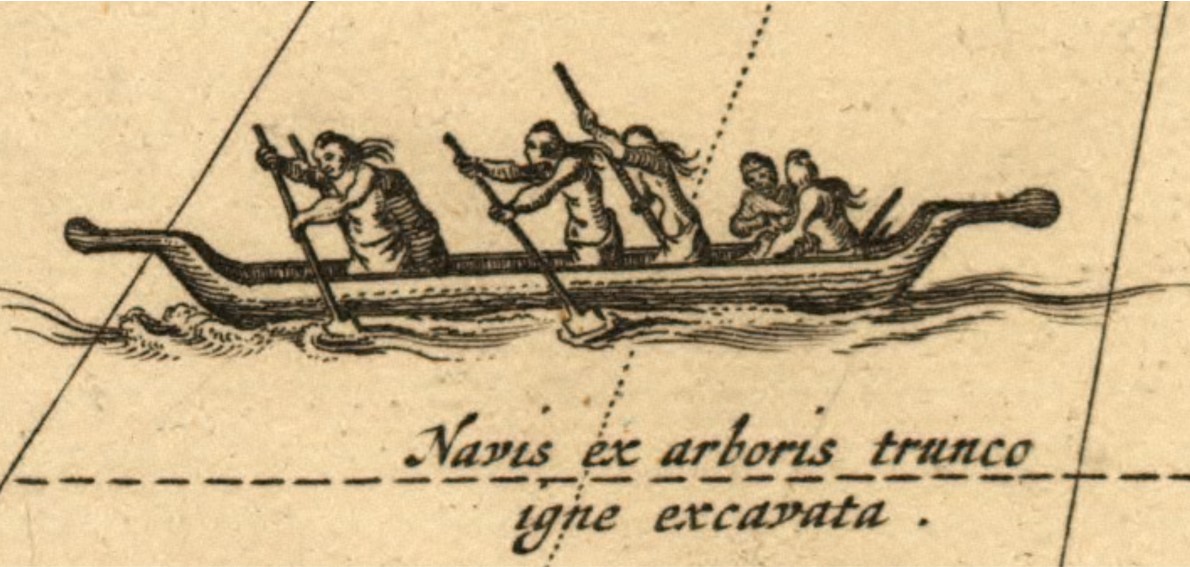
“The manner of making their boates” engraving by Theodor De Bry after a John White watercolor (printed 1590).
Among the Algonkian people of the southern New Netherlands Colony, Canoes were known in the Unami dialect of the Lenape language as Mùxul (pronounced Moo hool). But these boats have many other names in different communities who live in the land that once was southern New Netherlands. The canoe or Mùxul was the main Native American mode of travel, trade and communication outside of running on foot.
Typically, these canoes were constructed from one entire tree. After felling the tree using fire and stone axes (and later iron trade axes), the axes would be used to process the trunk of a pine or medium hard wood. Once the tree lay on the ground stripped of bark, the top would of the enormous log would be flattened and coals from a fire would be placed on top begin a controlled burn that eventually hollowed out the canoe.
The sides of the canoe were covered in wet clay. This is to ensure that the side walls do not get too thin and the boat burns out evenly. Through careful burning, scraping out the charred wood and keeping the side walls burned out correctly but not too thin, a boat can be created in a matter of a week if work is consistent and weather conditions ideal.
Descriptions from the 17th century abound on the manufacture of these dugout canoes ;(1) “ Their canoes be made either of pine trees, which before they were acquainted with English tools, they burned hollow, scraping them smooth with clamshells and oyster shells, cutting their outsides with stone hatchets. These boats be not above a foot and a half or two feet wide and twenty foot long”.
(2) Mishoòn, an Indian boat or canoe made of a pine or oak or chestnut tree. I have seen a native go into the woods with his hatchet, carrying only a basket of corn with him and stones to strike fire. When he had felled his tree (being a chestnut), he made him a little house or shed of the bark of it, he puts fire and follows the burning of it with fire, in the midst in many places. His corn he boils and hath the brook by him, and sometimes angles for a little fish; but so he continues burning and hewing until he bath within ten or twelve days (lying there at his work alone) finished.”
(3) there are also hornbeams, some growing into big trees; junipers, whose wood resembles cedar; tulip trees, of which the Indians make their boats because they are so big”
Some of these dugout canoes were small ranging from 14 – 17 feet, used to navigate small lakes, ponds and deep rivers; others were quite large ranging from 20 – 30 feet long and were used largely for ocean, bay and estuarial travel, fishing, and transport of people and goods.
Other types of canoes that are mentioned in Dutch and English records are canoes made of bark, unfortunately “what kind” of bark is not usually mentioned but some sources that have survived have named elm bark (commonly used to cover homes) and of course there are historical and contemporary examples of birch bark canoes. In southern New Netherlands, birch trees would be scarce and elm bark would have been more common for a “disposable / temporary” canoe. Bark canoes were lightweight, and could be carried overland if necessary to get from one river to another.
However, we are fortunate that primary sources from New England some some from New Netherlands shed light on these bark canoes. (4) “When the Indians travel by water for trading purposes they always come down this river [Maquas-Kil – Mohawk River] in watercraft that they know how to make of tree bark.”
(5) Their boats, whereof we brought one to Bristol, were in proportion like a wherry of the River Thames, seventeen foot long and four foot broad, and made of the bark of a birch tree, far exceeding in bigness those of England. It was sewed together with strong and tough osiers or twigs [likely misidentifying split spruce, hemlock, white pine roots], and the seams covered over with rosin or turpentine little inferior in sweetness to frankincense, as we made trial by burning a little thereof on the coals at sundry times after our coming home. It was also open like a wherry and sharp at both ends, saving that the beak was a little bending roundly upward. And though it carried nine men standing upright, yet it weighed not at the most above sixty pounds in weight.”
Unfortunately not much is known about how these elm bark canoes were made in the 17th century; only really that they existed and were used; but it is likely that their construction would have been similar to the way a birch bark canoe is constructed.
Drew Shuptar-Rayvis
- Indian New England 1524-1674, Ronald Dale Karr , Pg 95, paragraph 1 , William Wood (1634) pg 102
- Indian New England 1524-1674, Ronald Dale Karr , Pg 95, paragraph 1 Roger Williams (1643), 131-34
- A Description of New Netherland , Adriaen Van Der Donck (1647) , paragraph 3 , page 27, of wood and vegetation
- A Description of New Netherland , Adriaen Van Der Donck (1647) , paragraph 1, pg 13, of the North River
- Indian New England 1524-1674, Ronald Dale Karr, pg 94, paragraph 1 , Martin Pring (1603) 64-65, Plymouth Massachusetts
The Pequot Museum has several videos showing the dugout building process: https://www.pequotmuseum.org/explore/mission-muhshoon-launch/
Tulip Poplar was often used in making mishoon.

Detail from Novi Belgii 1685, wikimedia commons

